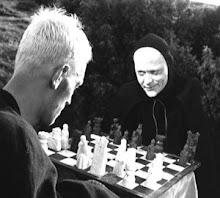Los Zopilotes
Black vultures are rare in most of CA, but may be seen occasionally in the high desert in fall and early spring --they migrate up and down from northern mexico, and the Sonora. They are big birds--larger and a bit hawk-like, compared to the usual turkey buzzards. The black vulture wings, up to 1.5 meters, show some white markings--another reason some mistake them for hawks--also noted in the spanish word "buitre" for vulture, like buteo (anglo-cized as "buzzard"). Buteo is latin for a species of hawk, but the early taxonomists errored in considering many American hawks, like red-tails, as vultures--the small hawks (goshawks, sparrowhawks) were correctly identified as Occipiters. The New world vultures are often called buzzards, but American buzzards (ie vultures) are not Buteo--to complicate matters further, the latin species name for the zopilotes,
coragyps, means "crow-like", presumably for the blackness.
Coragyps don't lack for an ominous quality, somewhat similar to crows or ravens, however. Indigenous Americans had myths for most birds, including vultures. In aztec tradition, the vultures are not quite carrion-birds or death omens. The vulture-deity, Cozcacuauhtli "signifies long life, wisdom, good counsel and mental equilibrium" (--though I suspect that's a bit exaggerated). Zopilotes, like turkey buzzards and condors, belong to the New World vultures family Cathartidae, unlike old world vultures, which are counted among Falconiforme, along with birds of prey--eagles, hawks, gyrefalcons. However old world Vulture classification among the true raptors has been questioned. Occipiters such as red tail hawks (Buteo jamaicensis) may have a superficial resemblance to vultures, but are an entirely different bird--far more muscular, with large talons, short, sharp beaks for ripping, and great hunters. Vultures are not birds of prey but scavengers (tho' Zopilotes reportedly will attack small calves and deer at times); they're built to glide, like their cousins, condors.

The mexican term for the black vulture, Zopilote, comes from náhuatl:
el nombre común zopilote viene del náhuatl tzopilotl donde "tzotl" significa inmundicia y "pilotl" colgar, haciendo referencia a que al volar llevan colgando de sus garras la carroña. Google-ando. The nahuatl glyph means something like filthy-carrion-carrier. The black vulture and
the colorful king vulture both make regular appearances in the aztec and mayan calendars--even at times appearing to copulate with human women. Muy hermosa. Flocks of black vultures above the mall....next, Chupacabras? Muy malo.










